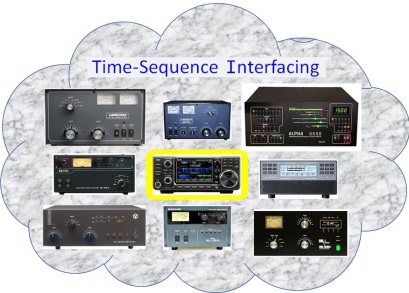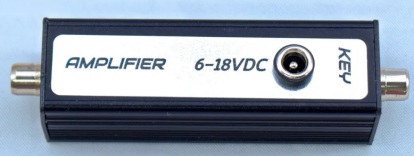IC-7300 Amplifiers Interfacing
WARNING:
DO NOT 'ASSUME' YOUR 7300 WILL WORK SEEMLESSLY WITH EVERY AMP.
- Some amplifiers use high voltage for keying their T/R relay. These amplifiers will damage the 7300 the very first time you key them.
- In most cases you must make at least one timing adjustment to the transceiver.
- Failure to make the proper timing adjustments to the 7300 USUALLY results in Hot Switching and possible damage to the amplifier.
QSK AMPLIFIERS:
If you own a Full QSK Linear Amplifier, you need not bother reading all of this page.
The IC-7300 will interface with any QSK Amp which may be keyed with Single-Line keying, and uses 12 volts d.c. to key its T/R relay.
However, it is advisable to adjust the 7300's TX-Delay to 10 miliseconds.
Press: Menu/Set/Function . . . then scroll using Multi-Knob to “TX Delay”.
Select TX Delay (touch-screen), then choose “HF”. Select “ON”, then adjust for 10 mS.
INTERFACING THE IC-7300 TO AMERITRON TUBE AMPLIFIERS*:
Unless you purchased the expensive QSK-5 PIN-Diode option for your Ameritron amplifier, you must make two timing adjustments to the 7300 before it will work properly with these amps, especially if you work CW or digital modes.
With its default settings, in CW mode the 7300 begins sending RF to the Amp faster than the Amp’s slow open-frame T/R relay can switch to TX.
You must change: TX Delay* and CW VOX Delay** (hang-time).
TX Delay is adjusted in the software menu and should be set to 25 mS.
This is a one-time adjustment and need not be touched again after setting.
Press: Menu/Set/Function . . . then scroll using Multi-Knob to “TX Delay”. Select TX Delay (touch-screen), then choose “HF”. Select "ON", then adjust for 25 mS.
CW VOX Delay (a.k.a. "Hang-Delay) is adjusted by pushing the VOX/BK-IN button on the front panel for at least one second. When the menu opens, adjust the hang-time (using Multi Knob) for at least 1/4 second of hang. This is done by trial and error while listening to the last dit or dah completing, and then waiting for the radio to return to RX. Adjust to suit your preference. You may change this parameter often, depending on how you are operating…and of course on the speed you are sending CW. Thus this adjustment is a front-panel adjustment.
Note: if you have it adjusted too short, the amp’s relay will attempt to follow the CW keying and the CLACKETY-CLACK-CLACK noise it makes will wake the dead.
*TX DELAY defines the time that the 7300 will wait after the first dit (or dah) begins, before transmitting RF. The wait is necessary to allow time for the amp’s slow T/R relay to switch. If you don’t set this properly, you will have hot switching.
You won’t notice any negative affect of hot switching for at least a year, but eventually the amp’s relay will begin to stick. You notice this when you cease transmitting and find that the receiver fails to receive anything, or if anything, then much weaker than it should be. This is due to burnt contacts on the relay.
The constant arcing of the relay over a longer period of time causes a build-up of black crud (carbon ?) on the relay contacts, which inserts a resistance between the contacts. Worse yet, it may even cause the relay contacts to pit.
**CW VOX Delay adjusts the length of time that the amp’s relay remains in the TX position, before releasing and returning to RX. When contesting at higher speeds, say 30 wpm and higher, I set this relatively short (perhaps ¼ second) so that I don’t miss the first part of the QSO partner’s response. In daily use (normal QSO’s), I set it to about one second to reduce relay chatter. This makes it less hectic and I maintain my sanity.
I’ve owned 4 Ameritron amplifiers and have been using them for over 30 years. I am very familiar with what happens with them when you fail to adjust the timing properly.
I often see new owners of Ameritron Amps respond with “works fine for me as is”. Each time I tell the OM, “wait about a year.”
*CAUTION: AMERITRON claims their Amp's use a very fast T/R relay that switches in just 15 miliseconds. NONESENSE! These relays have an average switching time of about 20 ms and in some cases (worst case) need 22 ms to switch and settle. Thus a TX-Delay of 25 ms is required.
15 ms is the 'raw spec' of the relay, measured when switched just one time. It does not include settling time (1 to 2 ms), nor the delay caused by the reverse-biased diode (1 to 2 ms). In addition, when the relay is trying to follow CW keying, it is even slower!
INTERFACING THE 7300 TO OLDER TUBE AMPLIFIERS
In the days when our radios used "tubes", most amplifiers used high voltage T/R (Transmit/Receive) relays.
Some relays switched with 110 VAC, some with 150 VDC (or even higher). The relays switching with D.C. voltage usually used negative voltage.
Regardless, ALL of these will instantly kill the IC-7300
the first time you attempt to key the amp.
If you want to use your 7300 with this type of amp, you must use an external keying relay (as described in the 7300 manual), or purchase one of the 3rd party "Soft-Key" or "Amp-Key" options available on the market.
DO YOUR OWN DUE DILLIGENCE!
EXAMPLES: AMP-KEYING INTERFACES:
SUMMARY:
The ICOM IC-7300 is a modern transceiver incorporating all of the necessary timing adjustments required for interfacing directly to [almost] ALL modern linear amplifiers using single-line, 12 vdc switching. BUT IT IS NOT PLUG-N-PLAY.
Indeed, the user must asscess the timing characteristics of the amplifier and adjust the 7300's time-sequency accordingly.
DOWNLOAD TIMING RECOMMENDATIONS:
DOWNLOAD TIPS FOR KEYING AN EXTERNAL NON-ICOM AMPLIFIER:
This document addresses CW Rise Time, TX-Delay Settings, and CW VOX Hang-Delay Settings. It references the pages in the respective manuals.
IC-7300 Amp Keying.pdf
PDF-Dokument [790.9 KB]
DISCLAIMER:
The information on this page is, to the best of my knowledge, accurate.
However, no responsibility is taken for its accuracy.
DO YOUR OWN DUE-DILLIGENCE.



























